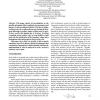Free Online Productivity Tools
i2Speak
i2Symbol
i2OCR
iTex2Img
iWeb2Print
iWeb2Shot
i2Type
iPdf2Split
iPdf2Merge
i2Bopomofo
i2Arabic
i2Style
i2Image
i2PDF
iLatex2Rtf
Sci2ools
CEC
2003
IEEE
2003
IEEE
Genome-physics interaction as a new concept to reduce the number of genetic parameters in artificial evolution
This paper reports on investigations on the possible advantage of the coupling between genomes and physics of cells in artificial evolution. The idea is simple: evolution can rely on physical processes during development allowing to produce shapes without need to specify how exactly this shaping has to be done. Evolving a minimal energy surface such as soap bubbles would need only the specification of the boundary values and a homogenous interaction pattern between the cells. This paper shows that it is possible to link a genetic regulatory network to physics during development, that a reduction of parameters is indeed possible and that the understanding of what is going on in such a system is relatively easy to gain.
Artificial Intelligence | CEC 2003 | Homogenous Interaction Pattern | Minimal Energy Surface | Possible Advantage |
| Added | 23 Aug 2010 |
| Updated | 23 Aug 2010 |
| Type | Conference |
| Year | 2003 |
| Where | CEC |
| Authors | Peter Eggenberger Hotz |
Comments (0)

